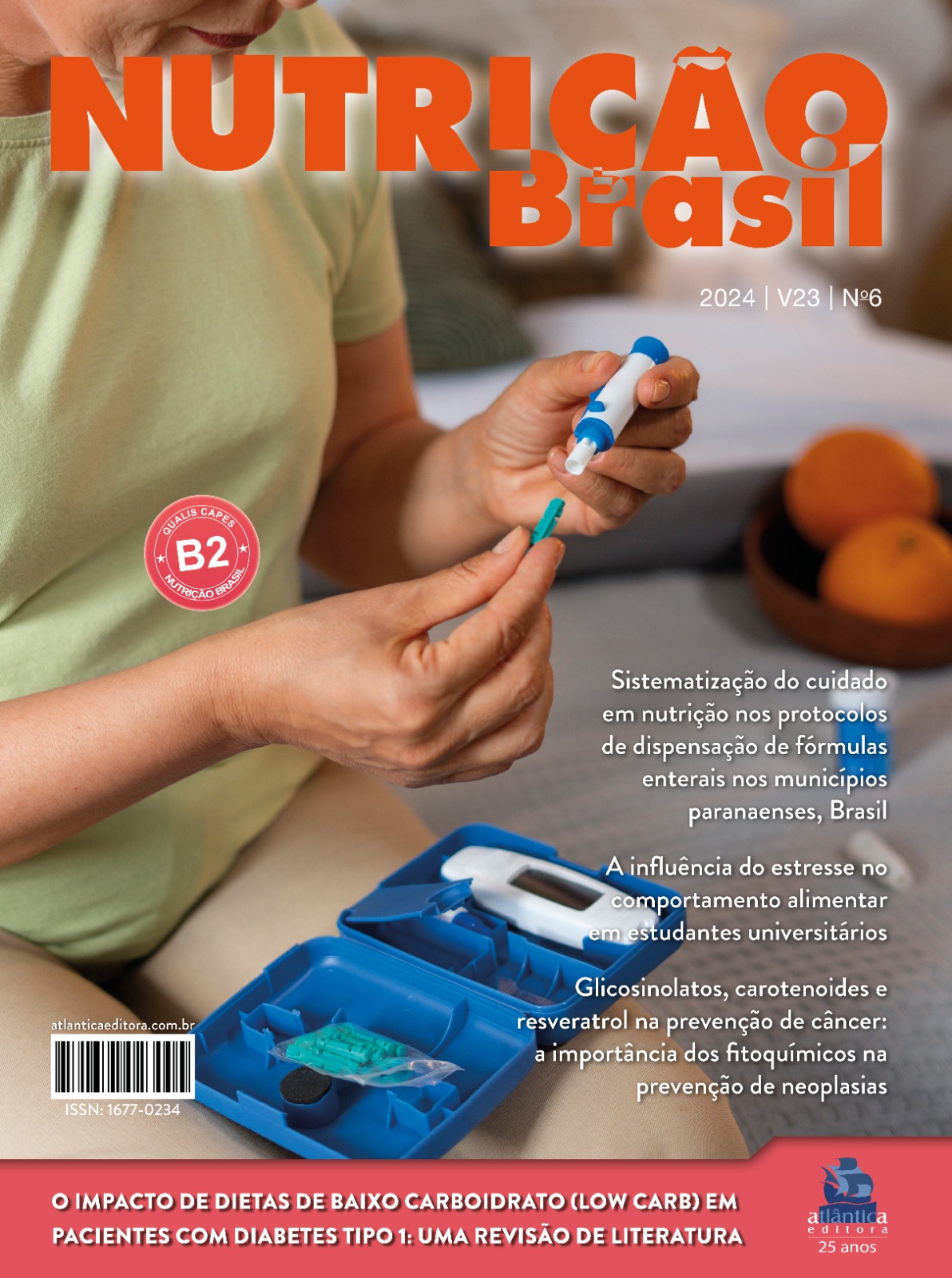Glucosinolates, carotenoids, and resveratrol in cancer prevention: the importance of phytochemicals in neuplasia prevention
DOI:
https://doi.org/10.62827/nb.v23i6.3049Keywords:
Neoplasms; Disease Prevention; Isothiocyanates; Carotenoids; Resveratrol.Abstract
Introduction: Glucosinolates, carotenoids, and resveratrol are phytochemicals, non-nutritive compounds found in foods, that play a crucial role in cancer protection. Objective: To describe the effects of bioactive compounds, including glucosinolates, carotenoids, and resveratrol, in the prevention of neoplasms. Methods: This study consists of a literature review utilizing retrospective analyses of scientific publications. Descriptors such as "Neoplasms," "Prevention," "Glucosinolates," "Carotenoids," and "Resveratrol" were employed in databases such as SciELO, PubMed, and Google Scholar. Results: Sulforaphane demonstrates properties that reduce cell proliferation and increase apoptosis, inhibiting tumor growth. High levels of beta-carotene in the blood are associated with a 17% reduction in the risk of developing breast cancer. Resveratrol may inhibit the migration of cancer cells by decreasing the expression and secretion of proteins related to the metastatic process. Conclusion: Phytochemicals such as glucosinolates, carotenoids, and resveratrol play a fundamental role in cancer prevention by regulating various signaling pathways at different stages of the disease.
References
Instituto Nacional de Câncer (INCA). Estimativa 2023: incidência de câncer no Brasil. [Internet]. 2023 [acessado 2024 Out 26]. Disponível em: https://www.inca.gov.br/publicacoes/livros/estimativa-2023-incidencia-de-cancer-no-brasil
Alves MM. Alimentos funcionais no tratamento e prevenção do câncer de mama. Brasília: Centro Universitário de Brasília – UNICEUB; 2018. Disponível em: https://repositorio.uniceub.br/jspui/handle/235/12697
Liu RH. Health-promoting components of fruits and vegetables in the diet. Adv Nutr. 2013 May 1;4(3):384S-92S. doi: 10.3945/an.112.003517. PMID: 23674808; PMCID: PMC3650511. Disponível em: https://pmc.ncbi.nlm.nih.gov/articles/PMC3650511/
Nandini DB, Rao RS, Deepak BS, Reddy PB. Sulforaphane in broccoli: The green chemoprevention!! Role in cancer prevention and therapy. J Oral Maxillofac Pathol. 2020 May-Aug;24(2):405. doi: 10.4103/jomfp.JOMFP_126_19. Epub 2020 Sep 9. PMID: 33456268; PMCID: PMC7802872. Disponível em: https://www.ncbi.nlm.nih.gov/pmc/articles/PMC7802872/
Shami E, Moreira EA. Licopeno como agente antioxidante. Rev. Nutr. 17 (2); Jun 2004. https://doi.org/10.1590/S1415-52732004000200009. Disponível em: https://www.scielo.br/j/rn/a/sJ6qRLvhXvkQR6CjnKgZN7K/?lang=pt&format=pdf
Galiniak S, Aebisher D, Bartusik-Aebisher D. Health benefits of resveratrol administration. Acta Biochim Pol. 2019 Feb 28;66(1):13-21. doi: 10.18388/abp.2018_2749. PMID: 30816367.Disponível em: https://pubmed.ncbi.nlm.nih.gov/30816367/
Ağagündüz D, Şahin TÖ, Yılmaz B, Ekenci KD, Duyar Özer Ş, Capasso R. Cruciferous Vegetables and Their Bioactive Metabolites: from Prevention to Novel Therapies of Colorectal Cancer. Evid Based Complement Alternat Med. 2022 Apr 11;2022:1534083. doi: 10.1155/2022/1534083. PMID: 35449807; PMCID: PMC9017484. Disponível em: https://www.ncbi.nlm.nih.gov/pmc/articles/PMC9017484/
Soundararajan P, Kim JS. Anti-Carcinogenic Glucosinolates in Cruciferous Vegetables and Their Antagonistic Effects on Prevention of Cancers. Molecules. 2018 Nov 15;23(11):2983. doi: 10.3390/molecules23112983. PMID: 30445746; PMCID: PMC6278308.Disponível em: https://pubmed.ncbi.nlm.nih.gov/30445746/
Mokbel K, Mokbel K. Chemoprevention of Breast Cancer With Vitamins and Micronutrients: A Concise Review. In Vivo. 2019 Jul-Aug;33(4):983-997. doi: 10.21873/invivo.11568. PMID: 31280187; PMCID: PMC6689356.Disponível em: https://pubmed.ncbi.nlm.nih.gov/31280187/
Ronco AL, De Stefani E, Mendoza B, Abbona E, et al. Dietary patterns and breast cancer risk: a factor analysis of foods and nutrients. Rev. Méd. Urug. vol.32 no.4. Disponível em: http://www.scielo.edu.uy/scielo.php?script=sci_arttext&pid=S1688-03902016000400003.
Song X, Luo Y, Ma L, Hu X, Simal-Gandara J, Wang LS, Bajpai VK, Xiao J, Chen F. Recent trends and advances in the epidemiology, synergism, and delivery system of lycopene as an anti-cancer agent. Semin Cancer Biol. 2021 Aug;73:331-346. doi: 10.1016/j.semcancer.2021.03.028. Epub 2021 Mar 29. PMID: 33794344. Disponível em: https://pubmed.ncbi.nlm.nih.gov/33794344/
Saini RK, Prasad P, Lokesh V, Shang X, Shin J, Keum YS, Lee JH. Carotenoids: Dietary Sources, Extraction, Encapsulation, Bioavailability, and Health Benefits-A Review of Recent Advancements. Antioxidants (Basel). 2022 Apr 18;11(4):795. doi: 10.3390/antiox11040795. PMID: 35453480; PMCID: PMC9025559. Disponível em: https://pubmed.ncbi.nlm.nih.gov/35453480/
Almeida TC, Silva GN. Effects of resveratrol on bladder cancer: a mini review. Human and Medical Genetics Genet. Mol. Biol. 44 (1) 2021 https://doi.org/10.1590/1678-4685-GMB-2020-0371 Disponível em: https://www.scielo.br/j/gmb/a/3YMdMnW3Tp3SnFJwrDytJJP/?lang=en
Sun Y, Zhou QM, Lu YY, Zhang H, Chen QL, Zhao M, Su SB. Resveratrol Inhibits the Migration and Metastasis of MDA-MB-231 Human Breast Cancer by Reversing TGF-β1-Induced Epithelial-Mesenchymal Transition. Molecules. 2019 Mar 21;24(6):1131. doi: 10.3390/molecules24061131. PMID: 30901941; PMCID: PMC6471699.Disponível em: https://www.ncbi.nlm.nih.gov/pmc/articles/PMC6471699/
Downloads
Published
Issue
Section
License
Copyright (c) 2025 Jadson Lustosa Quaresma , Danilo Carvalho Oliveira , Odara Maria de Sousa Sá (Autor)

This work is licensed under a Creative Commons Attribution 4.0 International License.
Autores que publicam nesta revista concordam com os seguintes termos:
Autores mantém os direitos autorais e concedem à revista o direito de primeira publicação, com o trabalho simultaneamente licenciado sob a Licença Creative Commons Attribution 4.0 que permite o compartilhamento do trabalho com reconhecimento da autoria e publicação inicial nesta revista.
Autores têm autorização para distribuição não-exclusiva da versão do trabalho publicada nesta revista (ex.: publicar em repositório institucional ou como capítulo de livro), com reconhecimento de autoria e publicação inicial nesta revista.





